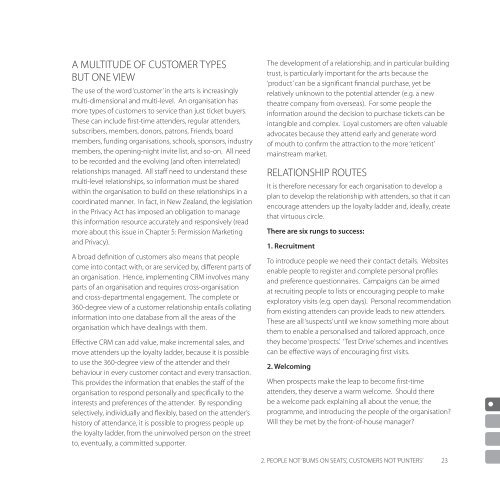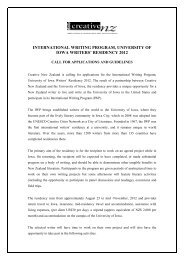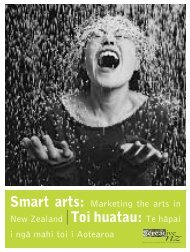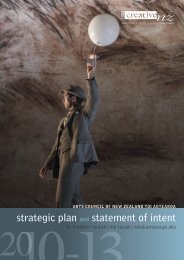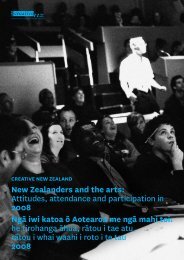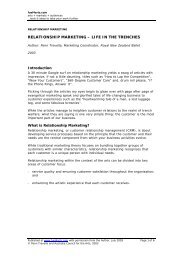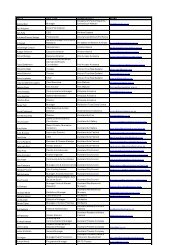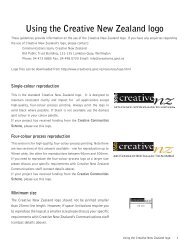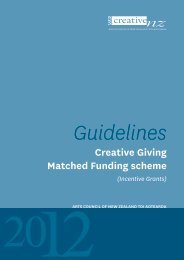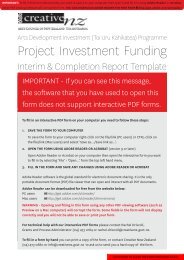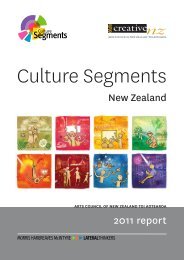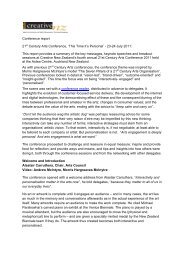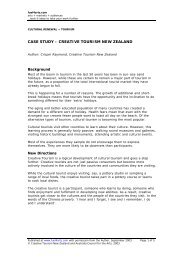FULL HOUSE Turning Data into Audiences - Creative New Zealand
FULL HOUSE Turning Data into Audiences - Creative New Zealand
FULL HOUSE Turning Data into Audiences - Creative New Zealand
You also want an ePaper? Increase the reach of your titles
YUMPU automatically turns print PDFs into web optimized ePapers that Google loves.
A MULTITUDE OF CUSTOMER TYPES<br />
BUT ONE VIEW<br />
The use of the word ‘customer’ in the arts is increasingly<br />
multi-dimensional and multi-level. An organisation has<br />
more types of customers to service than just ticket buyers.<br />
These can include first-time attenders, regular attenders,<br />
subscribers, members, donors, patrons, Friends, board<br />
members, funding organisations, schools, sponsors, industry<br />
members, the opening-night invite list, and so-on. All need<br />
to be recorded and the evolving (and often interrelated)<br />
relationships managed. All staff need to understand these<br />
multi-level relationships, so information must be shared<br />
within the organisation to build on these relationships in a<br />
coordinated manner. In fact, in <strong>New</strong> <strong>Zealand</strong>, the legislation<br />
in the Privacy Act has imposed an obligation to manage<br />
this information resource accurately and responsively (read<br />
more about this issue in Chapter 5: Permission Marketing<br />
and Privacy).<br />
A broad definition of customers also means that people<br />
come <strong>into</strong> contact with, or are serviced by, different parts of<br />
an organisation. Hence, implementing CRM involves many<br />
parts of an organisation and requires cross-organisation<br />
and cross-departmental engagement. The complete or<br />
360-degree view of a customer relationship entails collating<br />
information <strong>into</strong> one database from all the areas of the<br />
organisation which have dealings with them.<br />
Effective CRM can add value, make incremental sales, and<br />
move attenders up the loyalty ladder, because it is possible<br />
to use the 360-degree view of the attender and their<br />
behaviour in every customer contact and every transaction.<br />
This provides the information that enables the staff of the<br />
organisation to respond personally and specifically to the<br />
interests and preferences of the attender. By responding<br />
selectively, individually and flexibly, based on the attender’s<br />
history of attendance, it is possible to progress people up<br />
the loyalty ladder, from the uninvolved person on the street<br />
to, eventually, a committed supporter.<br />
The development of a relationship, and in particular building<br />
trust, is particularly important for the arts because the<br />
‘product’ can be a significant financial purchase, yet be<br />
relatively unknown to the potential attender (e.g. a new<br />
theatre company from overseas). For some people the<br />
information around the decision to purchase tickets can be<br />
intangible and complex. Loyal customers are often valuable<br />
advocates because they attend early and generate word<br />
of mouth to confirm the attraction to the more ‘reticent’<br />
mainstream market.<br />
RELATIONSHIP ROUTES<br />
It is therefore necessary for each organisation to develop a<br />
plan to develop the relationship with attenders, so that it can<br />
encourage attenders up the loyalty ladder and, ideally, create<br />
that virtuous circle.<br />
There are six rungs to success:<br />
1. Recruitment<br />
To introduce people we need their contact details. Websites<br />
enable people to register and complete personal profiles<br />
and preference questionnaires. Campaigns can be aimed<br />
at recruiting people to lists or encouraging people to make<br />
exploratory visits (e.g. open days). Personal recommendation<br />
from existing attenders can provide leads to new attenders.<br />
These are all ‘suspects’ until we know something more about<br />
them to enable a personalised and tailored approach, once<br />
they become ‘prospects’. ‘Test Drive’ schemes and incentives<br />
can be effective ways of encouraging first visits.<br />
2. Welcoming<br />
When prospects make the leap to become first-time<br />
attenders, they deserve a warm welcome. Should there<br />
be a welcome pack explaining all about the venue, the<br />
programme, and introducing the people of the organisation?<br />
Will they be met by the front-of-house manager?<br />
2. PEOPLE NOT ‘BUMS ON SEATS’, CUSTOMERS NOT ‘PUNTERS’<br />
23


